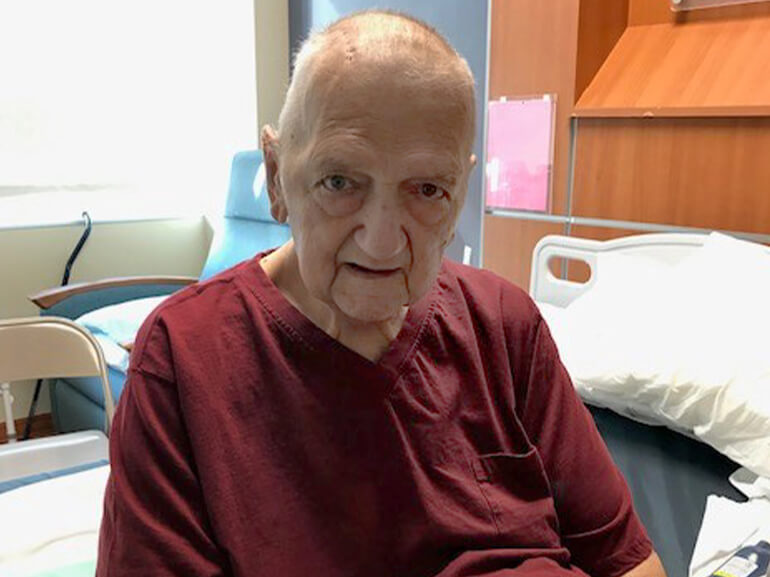Jim's story

James “Jim” Bailey, 73, works as a flooring salesperson. He and his wife enjoy going to ball games, out to dinner, spending time with their children and grandchildren and traveling. Late one April night, Jim was lying in bed when his wife noticed that he was shaking uncontrollably. She called 911 and he was taken to SSM Health DePaul Hospital. There, Jim tested positive for COVID-19, but that wasn’t the most urgent matter – a CAT scan showed a brain bleed caused by a seizure. Doctors performed brain surgery and for the next three weeks, Jim was placed on a ventilator, completely unaware of what was happening to him.
After Jim was stabilized, he was transferred to SSM Health Rehabilitation Hospital – Bridgeton for further recovery. Upon admission, Jim said, “I could not do most things like walking, balancing, being able to take a shower, going to the restroom, shaving…just everyday things you take for granted.” He was still on supplemental oxygen and unable to eat or drink because of swallowing issues.
Jim worked with his physician-led interdisciplinary team, including physical, occupational and speech therapists, to help work toward his goals of improving strength and endurance so that he could return to being “a contributing member of society.”
In speech therapy, Jim worked with his therapists to improve his swallowing. When he arrived at the hospital, he was unable to take any food, drink or medications by mouth. His goal, of course, was to return to normal eating and drinking without needing to modify the textures. Jim’s speech therapist performed a fiberoptic endoscopic evaluation of swallowing (FEES) assessment, where a thin, flexible scope is fed through the nose to help assess swallowing ability and safety. Following the evaluation, Jim’s speech therapist developed an exercise program for him to target the specific areas that were weak in his throat. During sessions, Jim and his therapist also utilized relaxation exercises during times of increased stress/anxiety. “Jim was always diligent in completing his exercises outside of therapy sessions as prescribed which contributed to his amazing progress,” said his speech therapist.
Physical therapy focused on increasing Jim’s independence with walking, balance and endurance. Jim started walking with a platform attachment on the parallel bars, taking just three steps at a time, then worked on going up and down stairs. While this was exhausting at first, he worked hard each day to improve so he would be able to walk up the stairs in his split-level home once he was discharged. Jim’s physical therapist said that he “was incredibly motivated and determined and always was looking to achieve more. Jim never gave up and kept looking forward.”
Due to his severe weakness, Jim’s goals in occupational therapy were to be more independent with his transfers and his bathing, grooming, dressing and toileting. His therapist worked with him to use a transfer board to move from his wheelchair to the bed or the toilet. Once Jim was better able to transfer, he and his therapist practiced ways to adapt his personal care and other day-to-day activities. They also incorporated Wii Bowling into his therapy, which Jim really enjoyed.
The turning point in Jim’s journey was when he realized that he “needed to have faith and show up to do what I needed to do every day.” After this realization, Jim said, “All I did from that moment on was go into therapy and do what I was supposed to do and just focus on one step at time. In that moment everything changed and my therapy really took off.” Jim credits his family and friends for their ongoing support since the beginning of his journey and is appreciative that they have continued to push him forward. Jim’s wife also attended family training sessions to make his transition from the hospital back to his home easier.
After 28 days at SSM Health Rehabilitation Hospital, Jim had made tremendous progress toward his recovery. He was able to consume food and liquids with the use of various safe swallow strategies to reduce his risk for aspiration. He no longer required supplemental oxygen and was able to navigate stairs and walk 250 feet with a walker. Jim also regained the strength needed to complete all of his personal care independently.
Upon discharge, Jim continued his therapy at the SSM Health Day Institute. He is most looking forward to being home with his family and pets. For others facing a recovery that may feel overwhelming, Jim offers this advice: “You can’t give up. You have to have hope and do everything you can do to get better. You may not be successful in everything you do, but you need to do it.”